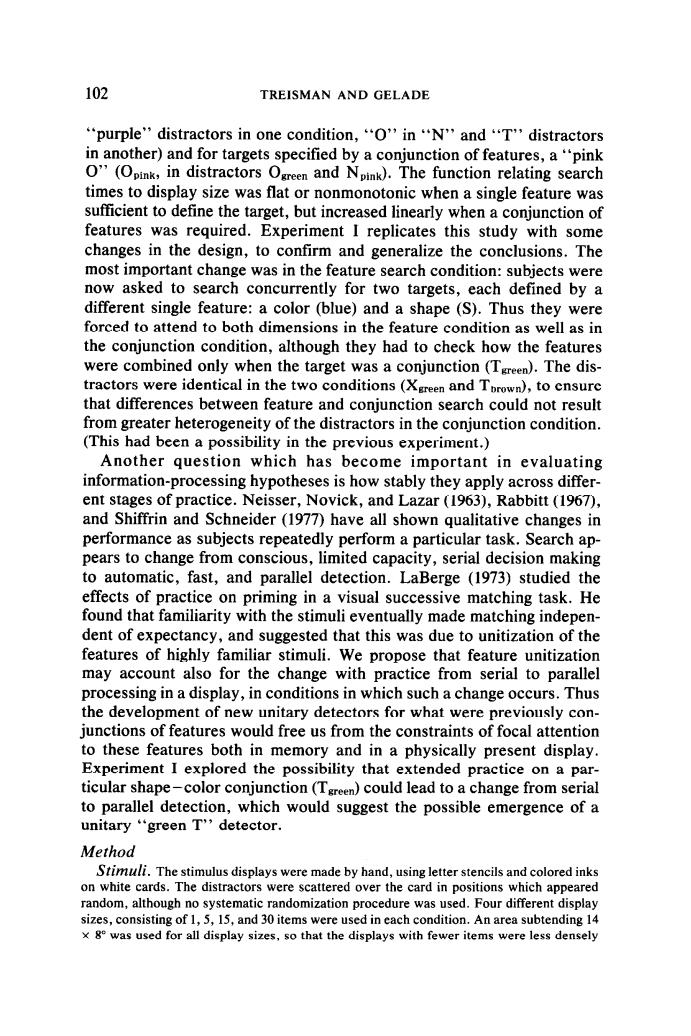正在加载图片...

102 TREISMAN AND GELADE “purple"distractors in one condition,.“O'in“N'and“T'distractors in another)and for targets specified by a conjunction of features,a"pink O"'(Opink,in distractors Oeen and Npink).The function relating search when a single feature was target,but increased ir inearly w hen a conjunction of features was required.Experiment I replicates this study with some changes in the design,to confirm and generalize the conclusions.The most important change was in the feature search condition'subiects were now asked to search concurrently for two targets,each defined by different single fe color(blue) and a shape(S).Thus the were forced to attend to both dim sions in the feature condition as well as in the conjunction condition,although they had to check how the features were combined only when the target was a conjunction (T).The dis- tractors were identical in the two conditions(X and T. )to ensure that differences between feature and conjunction fromgrn a possibility in the previous experiment. fr ty o the distractors in the conjunction condition. Another question which has become important in evaluating information-processing hypotheses is how stably they apply across differ- ent stages of practice.Neisser,Novick,and Lazar (1963).Rabbitt (1967). and Shiffrin and Schneider(1977)have all showr alitative chang in performance as subjects repeatedly perform a particu task. Search ap- pears to change from conscious. limited capacity,serial decision making to automatic,fast,and parallel detection.LaBerge (1973)studied the effects of practice on priming in a visual successive matching task.He found that familiarity with the stimuli eventually made indepe dent of ex suggested that this was due to unitization of th features of highly fami iar stimuli.We propose that feature unitization may account also for the change with practice from serial to parallel processing in a display,in conditions in which such a change occurs.Thus the development of new unitary detectors for what were previously con nctions of features would fre eus from the constraints of focal attentior the re th 00 memory and in a phys cally present display ent I explored the possi ility that extended practice on a par ticular shape -color conjunction (Tgreen)could lead to a change from serial to parallel detection,which would suggest the possible emergence of a unitary "green T"detector. Method Stimuli.The stimulus displays were made by hand.using letter stencils and colored ink on white cards.The distractors were scattered over the card in positions which appeared random,although no systematic randomization procedure was used Four different display 15,and 30 items in cach An area s th f102 TREISMAN AND GELADE “purple” distracters in one condition, “0” in “N” and “T” distracters in another) and for targets specified by a conjunction of features, a “pink 0” COpink in distracters O,,,, and Npink). The function relating search times to display size was flat or nonmonotonic when a single feature was sufficient to define the target, but increased linearly when a conjunction of features was required. Experiment I replicates this study with some changes in the design, to confirm and generalize the conclusions. The most important change was in the feature search condition: subjects were now asked to search concurrently for two targets, each defined by a different single feature: a color (blue) and a shape (S). Thus they were forced to attend to both dimensions in the feature condition as well as in the conjunction condition, although they had to check how the features were combined only when the target was a conjunction (Tg,.,,,). The distractors were identical in the two conditions (X,,,, and Thrown), to ensure that differences between feature and conjunction search could not result from greater heterogeneity of the distracters in the conjunction condition. (This had been a possibility in the previous experiment.) Another question which has become important in evaluating information-processing hypotheses is how stably they apply across different stages of practice. Neisser, Novick, and Lazar (1963), Rabbitt (1967), and Shiffrin and Schneider (1977) have all shown qualitative changes in performance as subjects repeatedly perform a particular task. Search appears to change from conscious, limited capacity, serial decision making to automatic, fast, and parallel detection. LaBerge (1973) studied the effects of practice on priming in a visual successive matching task. He found that familiarity with the stimuli eventually made matching independent of expectancy, and suggested that this was due to unitization of the features of highly familiar stimuli. We propose that feature unitization may account also for the change with practice from serial to parallel processing in a display, in conditions in which such a change occurs. Thus the development of new unitary detectors for what were previously conjunctions of features would free us from the constraints of focal attention to these features both in memory and in a physically present display. Experiment I explored the possibility that extended practice on a particular shape-color conjunction (T preen) could lead to a change from serial to parallel detection, which would suggest the possible emergence of a unitary “green T” detector. Method Stir?&. The stimulus displays were made by hand, using letter stencils and colored inks on white cards. The distracters were scattered over the card in positions which appeared random, although no systematic randomization procedure was used. Four different display sizes, consisting of 1,5, 15, and 30 items were used in each condition. An area subtending 14 x 8” was used for all display sizes, so that the displays with fewer items were less densely